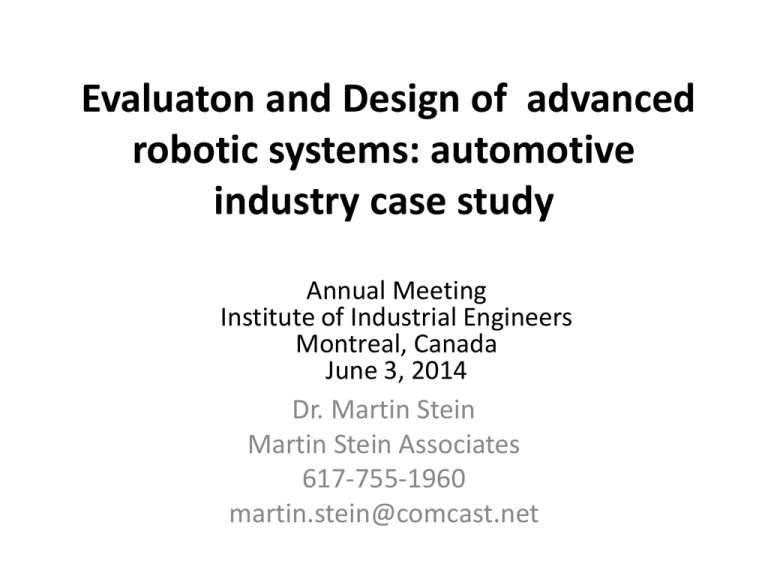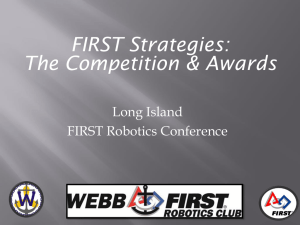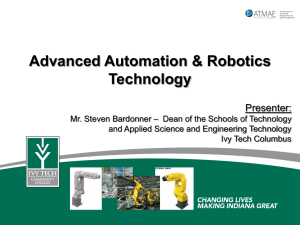Evaluaton and Design of advanced robotic systems - X
advertisement

Evaluaton and Design of advanced robotic systems: automotive industry case study Annual Meeting Institute of Industrial Engineers Montreal, Canada June 3, 2014 Dr. Martin Stein Martin Stein Associates 617-755-1960 martin.stein@comcast.net Executive Summary • The Author proposes a systematic process for evaluation and design of advanced robotics technologies. • A case study for a major automotive industry company was conducted to refine the methodology. • The case study provided preliminary observations necessary to design a pilot application of advanced or collaborative robotics and to prepare a design for the testing and pilot demonstration of these operations. • Examples of operations that were evaluated in depth are the automated unloading of laser created parts and insertion of specialized fasteners. … Executive Summary • The evaluation methodology is designed to provide an analysis of the benefits and costs of alternative technologies for automation of industrial processes including combinations of robotics technologies. • For example, fixed automation with a heavy duty arm with a compliant gripper, and computer vision. • The initial field assessments were conducted to refine the methodology. Background • Robotics technology is an enabler and provides companies with a competitive advantage. • At a recent conference of the Institute of Industrial Engineers, a presentation to evaluate advanced robotics technology was made by Dr. Stein and Dr. Torres-Jara. …Background • A field evaluation in three large automotive plants was conducted to review existing applications and consider how automation can provide economic and safety benefits to various industrial processes. • In addition, the applications of new advanced technologies such as collaborative robotics., and provide a consistent and standardized framework for testing and deployment of these technologies was considered. • Several opportunities were identified during the field evaluation that show potential for future research and testing. These opportunities are described below. Opportunities for Testing and Utilization of Collaborative Robotics • A new industrial revolution is creating a new breed of robots that can reduce labor, improve quality and safety in the automotive assembly and fabrication processes. • In the future, companies can take advantage of the new technologies but careful design, development and testing of these technologies is required. Potential Innovations • Fastener Insertion: Fabrication and Assembly • Selection of Specific Operations for Testing and Design • Preparation of Implementation Plan for Each Operation • Creation of Robotics Technology Data Base Additional Discussion and Review of these Opportunities: 1. Laser produced parts are converted directly into kits 1. Grabbing parts 2. Creating kits 2. Quality control 1. Tactile inspection 2. Recording 3D data on defects 3. Robotics configuration 1. Combine robotics technologies 2. Automated unloading of lasers, cut parts and press tending Phase II Tasks • Define technology options for suggested applications • Specify combinations and configurations • Design pilot applications • Follow-up Field and Laboratory Data collection to confirm application requirements Requirements • • • • • Robot Controller Communication Protocol Robot Controller Programmability CAD file formats used (2D and 3D) Communication Network User software interface for each application and operation • Laser or other machines involved: API Availability • AGV Software (if necessary) • Review existing automation operations and procedures Proposed Implementation for Phase II: Fastener Placing in the Chassis • The challenge in this implementation is recover a reference point so that the robot arm can operate. It is assumed that a 3D CAD model in a readable format exists. • The end effector needs to have compliance to perform the insertion. • Additional considerations depend on the how the chassis will be fixated during the operation. Sensitive Robotics Features • • • • Recover Reference Software Mobile to Avoid Conveyor Belts Holding of part not needed or is less necessary Also, utilizing YARP (Yet Another Robot Platform) for control and communication. Alternate Implementation for Phase II: Bending Press Operation • The complexity of this implementation depends on what is the complete task to implement and how the parts are feed. • If linked to the unloading of the laser cutters, the parts can come in mobile robot or together with a mobile arm. • Besides the complexity of changing the die sets, the robot should have some sort of compliant gripper to maintain contact with the part is this is bent. • In order to correctly place the part on the press, stoppers and compliant grippers are recommended for alignment. Alternative Implementation for Phase II: Unloading the Lasers • Moving the cut parts using a robot and the file used to cut the profiles. • It the robot arm to use is fixed next to the laser cutter. The solution is straight forward to implement. However, the robot should have a large reach to pile the parts in the right place. • A suction cup capable of rotating and detecting force is recommended. • The parts can be shipped in mobile robots to the press where another arm can continue the job. Alternative Implementation for Phase II: Overall System Integration • Most of robotic arms have controllers with limited capabilities to interface with external devices. • There are a number of technologies available for this task depending on the arm provider. • YARP and other software will allow interoperability with multiple systems to achieve the implementations desired. System Integration (Cont’d) • If a mobile platform with an arm (motorized or not) is used instead of a fixed arm, then the challenge is to recover the reference to start the operation. • A number of alternatives can be implemented to do this operation. It is recommended to use multiple sensing modalities in order to execute this critical operation. • The advantage of mobile arms to unload the laser cutter is that they can move to another laser cutter for operation seamlessly. Alternative Implementation for Phase II: Painting • Currently, a person visually inspects and retouches the work done by a robot. • The person has to wear a protective suit and can only work 2 hours because the gun is heavy the environment harsh. • Proposed implementation: – After the robot paints, a person outside the chamber can visually inspect the work using a camera mounted in the same robot. The person is outside the chamber and can teleoperate the painting robot. – If the current robot should not be used another robot can be placed in the current location of the operator to do this operation. – The result is that the person is not limited to 2 hours work and is not exposed to the harsh conditions of the painting room. Expected Benefits • Utilization of this framework will help accelerate implementation of potential robotics and automation investments. This will help maintain Competitive Advantage and increase quality, safety and customer satisfaction. • Risk associated with new implementations and technology implementations will be reduced through the use of outside resources. • Presentations for management will be created that facilitate early stages of robotics technology investment. • Data and analysis obtained during Phase II can also help create a Robotics Evaluation and Analysis Planning System data base (REAPS). Key Evaluation Factors • Authorization for Capital Expenditures require the evaluation of impacts on safety, quality, efficiency and delivery. • Key metrics also include the length of the payback time period, labor savings and the intangible benefits associated with reduced accidents and injuries. • Elements of the analysis include the existing and proposed configuration of equipment, standard robotics utilized, system integrators and software modifications. • For collaborative robotics, it will be necessary to consider the new RIA safety standards, and criteria such as zone of operation, speed and precision of the robot arm. Benefits and Costs for combinations of technologies will be necessary for decision making purposes. • Testing of equipment and combinations will be facilitated by the use of the specialized laboratory facilities such as ABB. Implementation of advanced manipulation robotics technology • Comprehensive database of basic and advanced robotics technologies. (REAPS) • Patented Robotics technology on manipulation, and contact feedback. • Proprietary software to simplify programmable operations in industrial environments. • Innovative designs and products for use in the agricultural industry will be proposed that can provide a competitive advantage. Advantages • A detailed and precise model of the environment/objects is needed – A CAD model is generally available for a static environment • Robotic arm is positioned with high precision – The control consists of a set of trajectories • No tactile sensing is used in general – Less sensor are needed – No wearing of the contact sensors • Complex programming – Advance tasks can be executed Sensitive manipulation technology • New kind of tactile sensors • Compliant actuators • Sensitive manipulation algorithms Tactile Sensors Displacement [Torres-Jara 2006, MIT CSAIL] Load Ridges Load Vertical Displacement • Designed for robotic manipulation • Different from traditional technologies Series Elastic Actuators (SEA) Pratt, Williamson, [1995] Motor Spring Force sensing Load • Compliant actuator with low mechanical impedance • Designed for force control Algorithms [Torres-Jara 2007, MIT CSAIL] • High level control based on tactile feedback • Detection of tactile sensor patterns to improve high and low level control Examples: Robots Obrero and Gobot • Obrero: Sensitive manipulation • Gobot: Fine sensitive manipulation • • • • http://youtu.be/KSFeGWWruqU http://youtu.be/KSFeGWWruqU http://youtu.be/vklnBXkjZIU http://youtu.be/NRX7P2YgQoE Tactico • Incorporate the lessons learned from Obrero and Gobot. – Hardware and software. • Robust and dexterous manipulation – Capable of handling “any” objects • Easy to program. Phase 3. Discussion of capabilities and limitations of advanced technologies. • Tasks that can be done differently with compliant robots. • Tasks that can be improved with tactile feedback. • Constraints that can be removed when implementing automation tasks. Phase 4. Conceptual framework for evaluating alternative robotic technology. • Robotic systems defined – Application in the work environment that utilize intelligent automated technology – Process for measuring the cost and benefits of substituting automated technology for manual labor – Process for creating innovative options for the use of automated technology in the work place Evaluation of alternative robotic systems and potential applications Workshop: Interviews Assessment Prioritize potential applications Specific process related requirements Business case • Productivity Benefits • Costs • Intangibles Recommendation • Investment • Human Capital • Pilot Functions: • Robotic •Fully aut. •Semi aut. • Non-robotic Prototype: • Technology • Process • Proof of Concept If robotics: •Advantages •Disadvantages Alternative Technologies: • Arm • Hand • Finger • Sensors Select Technologies Phase I Field Evaluation: Selected Components • For relevant processes and operations: Movement Type • Surface Type, Object Size and Weight, Precision Required • Platform Type • Vision Requirements • Manipulation Requirements • Environmental Factors • Human Interaction Phase II Analysis: Selected Factors • • • • • • • • • Force Requirements Sensing Requirements Compliant or Non Compliant Sensing Position Control Alternative Technological Solutions Instrumentation Sensing Human Interface Safety Regulation Compliance Advanced Technology: Pilot Proposal Phase III Prototype • Selected Technological Solutions: Automated and Robotics • Equipment Required for Laboratory • Tests Necessary in Laboratory • Benefits of Alternative Robotics Solutions • Costs of Alternative Robotics Solutions • Field Implementation Plan Phase IV Business Case • Management of Innovation Process Recommendations • Labor Savings Considerations • Safety and Environmental Impacts • Projections of Operating, Maintenance and Support Requirements • Payback Time Frame • Estimated Utilization Across North America • Estimated Utilization Globally Preliminary Observations and Suggestions • A broader assessment of the innovation process might yield important insights. • For example, how do competency teams communicate with each other? • What are the linkages between the process, employee and customer feedback mechanisms? • How can additional flexibility in supplier selection facilitate future innovation? Martin Stein Associates • Martin Stein, President, Martin Stein Associates – D.Sc. in Applied Mathematics, MA and BS Economics. Former Deputy Director, Center for Transportation, MIT – 30 years experience consulting on advanced technology in industry including projects for the US Department of Agriculture (Infrastructure), Ministry of Technology for the Government of Germany (MagLev) and Snap-On Tools (Van of the Future). – Clients include: Kellogg’s, GM, Toyota, US. DOT. – President-Elect of the Process Industries Division, Institute of Industrial Engineers.



